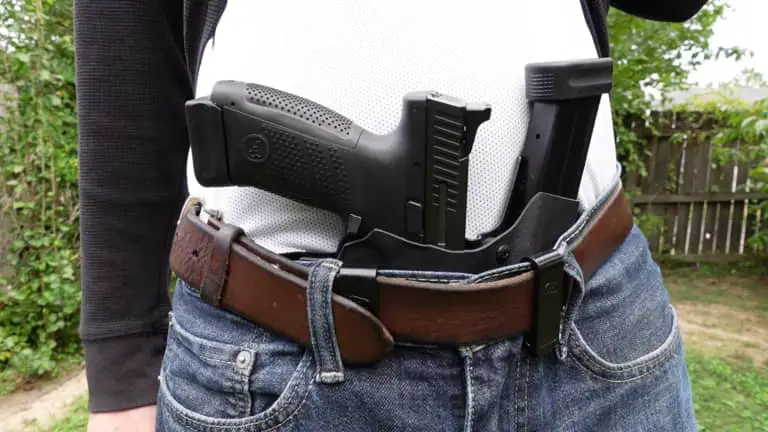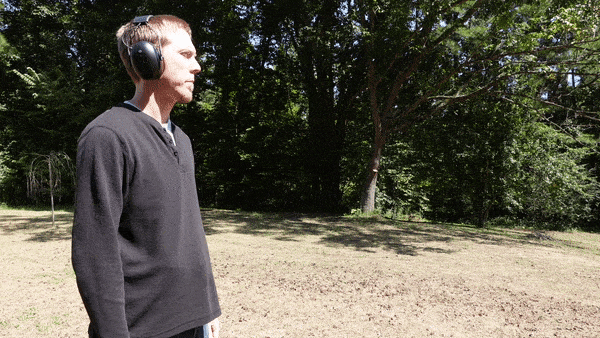
I have been thinking about appendix carry for a long time. I recently started aiwb carry using a good kydex holster. Here is what I learned about how to safely appendix carry.
Appendix carry can be safe. Always move cover garments out of the way when drawing and holstering. Keep fingers off the trigger until the pistol is on target. Don’t point the muzzle at body parts or bystanders. Look for cases or garment in the holster before holstering.
Drawing and holstering poorly can result in a life threatening injury. Leg arteries, intestines, and reproductive organs can be destroyed when appendix carrying goes wrong.
Drawing from the Appendix(AIWB)
Drawing from the appendix must be done correctly every time. Mistakes when drawing can be dangerous and render your pistol ineffective. For your safety and the safety of those around you, practice drawing with an unloaded pistol.
The following numbered list summarizes how to draw from an appendix holster. The paragraphs after the list go into more detail.
- 1 With your weak hand, grab and raise the cover garment well above the pistol.
- 2 Keep holding the cover garment until it’s time to drop it.
- 3 With your strong hand, grab the pistol grip.
- 4 Raise the pistol out of the holster.
- 5 Once out of the holster, move the pistol up and out to get it face level.
- 6 After the pistol is forward the cover garment, drop the garment.
- 7 After dropping the garment, move the week hand to the pistol.

Cover Garment Removal
The first part of appendix drawing is getting the cover garment out of the way. The cover garment can get caught on the pistol. If this happens, you will not be able to bring your pistol eye level. Even worse, the pistol may swing to the right or left when you try to raise it. This can result in pointing the pistol at a non-combatant. The cover garment can also prevent a strong grip. Drawing with a garment between your hand and pistol grip can result in a thrown or dropped gun.
With your weak hand, grab the garment where it ends. Pull it well above your pistol. Between your nipples is high enough. Maintain this grip until you draw and the pistol is well forward the garment.
Appendix(AIWB) Draw Stroke
Once the garment is out of the way, grip the pistol with your strong hand. The pistol’s grip should be in the same place every time. You should know where to grip without looking. This is where a good holster is crucial. An appendix holster needs strong clips to stop the holster from sliding on the belt.
Keep your finger out of and above the trigger guard when gripping and drawing. This should be a habit you have before carrying appendix. If you don’t have good trigger disciple, then you need to develop it. Practice drawing with good trigger finger placement with an unloaded pistol. The finger should only touch the trigger after the pistol is pointed at the target.
How to Holster in an Appendix Holster
The most important thing about holstering is to go slow. This is holstering not drawing. There are no threats to be neutralized. There is just a pistol to put back in it’s carry place.
The following numbered list summarizes how to holster AIWB. The paragraphs after the list go into more detail.
- 1Place your trigger finger above trigger and on the frame.
- 2Lift the cover garment with your weak hand.
- 3Turn the pistol to visual inspect trigger finger placement.
- 4Lean back and extend your waist forward.
- 5Look for cases or other objects inside the holster.
- 6Lower the pistol to the waist while turning the muzzle downward.
- 7Insert the pistol inside the holster firmly.
- 8Do not touch the trigger or point the muzzle at body parts and bystanders.

More Detailed Explanation of AIWB Holstering
First, bring your arms and pistol back toward your face. At this time, visually inspect the placement of your trigger finger. It should be as high above the trigger as possible. Also, this is the time to de-cock if your pistol has a hammer and put on the manual safety if it has one.
After lifting the cover garment, lean back a little and move your hips forward some. Look into the holster to see if a case, the cover garment, or anything else got in it. Anything in the holster can touch the trigger and cause an involuntary trigger pull.
Now the pistol can be placed in the holster. Slowly, move the muzzle into the holster’s mouth. If you have a double action pistol, you can place your thumb on the back of the hammer for an extra layer of safety. The muzzle should not be pointed at your person when moving it in. Yes, when a pistol is holstered it will be pointed at body parts. The trigger is covered by the holster so involuntary discharge is impossible. Even with strong side inside the waistband and outside the waistband holsters, the muzzle will still point at body parts when stepping, bending, and reaching. There is no way to carry a pistol on a belt holster without the muzzle pointing at the shooter’s body.
Choosing an Appendix Holster
It’s best to get a holster designed for appendix carry. A strong side inside the waistband holster might work if you are on a budget. However, iwb holsters on the appendix might be uncomfortable and they might not conceal as good as an appendix holster.
A good appendix holster will tilt the grip toward the belly for better concealment. This grip tilt prevents printing. A good appendix holster will also tilt the muzzle forward for comfort and safety. Also, it should have a mouth that stays open always. A bad appendix holster with a closed mouth is unsafe. It will require using the muzzle to open the mouth. This is unsafe and creates a bad habit.
The clips on an aiwb holster need to keep the holster from sliding. Good strong clips will keep the pistol grip in the same place. This is essential for a consistent, fast draw stroke.
Watch This Video to Learn More about Appendix Carry Safety